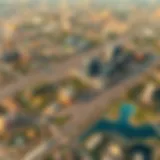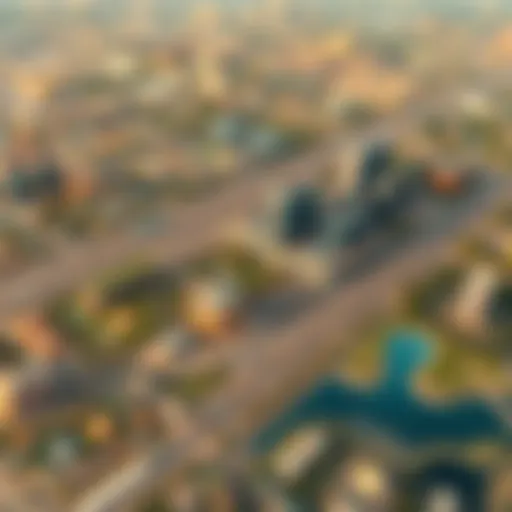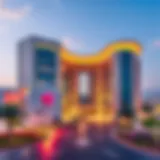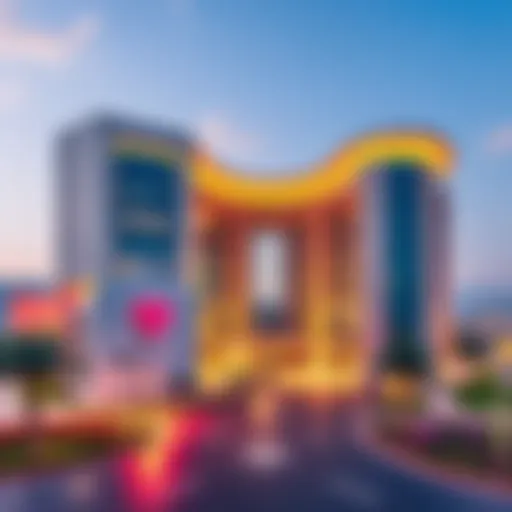Exploring the Unique Neighborhoods of Dubai
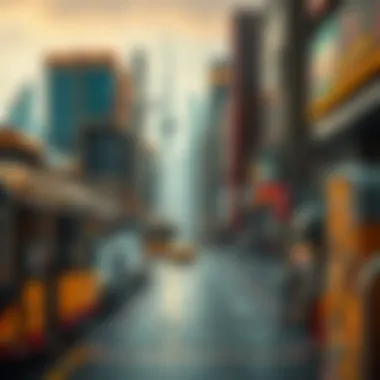

Intro
Dubai, a city that is constantly evolving, showcases a captivating blend of modernity and tradition within its diverse neighborhoods. Each area unfolds a rich tapestry of landscapes, cultural nuances, and community dynamics that are bound to pique the interest of residents, potential homeowners, and visitors alike. From luxurious waterfront properties in Dubai Marina to the artisanal charm of Al Fahidi, understanding these neighborhoods allows one to appreciate not just the aesthetics, but also the values and lifestyles that flourish within them. This examination will highlight key features that define Dubai's local landscapes and the community life that sprouts from them.
Neighborhood Features
Landscaping Highlights
Dubai's neighborhoods are adorned with greenery that contrasts sharply with the urban skyline. For example, Al Barsha surprises by offering parks such as Al Barsha Pond Park, which is a local favorite. Families enjoy sprawling lawns and picnic spots lined with palm trees, creating a relaxed atmosphere amid the bustling city.
In contrast, downtown Dubai exhibits a different kind of landscaping, where meticulously manicured gardens surround iconic structures like the Burj Khalifa. The area integrates art and nature through fountains and fine sculptures, enhancing the visitor's experience.
Notably, Jumeirah neighborhoods frequently showcase gardens that embrace Arabic tradition, with beautifully landscaped courtyards adorned with flowers typical of the region. This blend of flora not only beautifies but also promotes biodiversity.
Architectural Styles
Dubai is a melting pot of architectural styles, reflecting its historic roots and ambitious future. The Bastakiya Quarter, with its narrow lanes and wind towers, embodies traditional Emirati architecture, reminiscent of a bygone era.
In stark contrast, areas like the Palm Jumeirah display cutting-edge luxury residences that are both extravagant and innovative. These buildings often incorporate sustainable practices, revealing a step towards environmentally-conscious living.
The Dubai Design District goes a step further, showcasing cutting-edge designs and experimental structures, a playground for architects and designers. From sleek lines to organic shapes, this area stands as a testament to creativity and unique vision.
Community Life
Local Events and Activities
Cultural vitality thrives in Dubai's neighborhoods through a plethora of local events. Monthly, the Dubai Marina Walk transforms into a lively promenade for markets that feature local crafts and gourmet food. This encourages community engagement and fosters relationships among residents and visitors.
Another notable event is the Al Seef Festival, which celebrates Emirati heritage through art, music, and fashion, showcasing the rich culture that endures in neighborhoods like Al Seef. Such occasions bolster a sense of belonging and community pride.
Lifestyle Amenities
The quality of life in Dubai’s neighborhoods is enhanced by a range of lifestyle amenities. Dubai Hills Estate presents itself as a model community, combining residential units with essential services like schools, shopping malls, and recreational facilities, all within walking distance.
On the other hand, Deira offers a more eclectic experience, where souks and local eateries capture the spirit of traditional markets. Here, the community thrives on local commerce, allowing small businesses to flourish.
In summary, the neighborhoods of Dubai each tell their own distinct story, punctuated by unique landscapes, cultural influences, and community dynamics. Understanding these elements offers a new perspective on what life in this captivating city entails, blending tradition with modern living to create a mosaic that resonates with anyone who sets foot in this vibrant metropolis. Going beyond mere aesthetics, the neighborhoods of Dubai embody a living culture that is continuously evolving yet steadfast in its roots.
Prologue to Dubai's Neighborhoods
Dubai stands as a testament to modern urban life, blending cultures and lifestyles through its many neighborhoods. Each area is a world unto itself, reflecting not only its unique architecture but also its distinct community vibes. Understanding Dubai's neighborhoods is crucial for anyone interested in the city’s intricate tapestry of life and living.
Here, we will explore how these neighborhoods come into play, focusing on the rich cultural depth they hold and the vibrant community life they foster.
The importance of examining these neighborhoods extends beyond mere aesthetics; it addresses the lifestyle elements and socio-economic dynamics that shape people's daily lives. Visiting tourists, potential homeowners, and current residents will find that each area offers valuable insights into Dubai’s identity. Moreover, this knowledge enhances one’s experience of the city, allowing for a deeper appreciation of the environment and the people who call it home.
Historical Context
The story of Dubai's neighborhoods begins with its historical roots. Once a humble fishing village, Dubai has transformed dramatically over the decades. The discovery of oil in the 20th century marked a turning point, bringing in wealth that led to rapid urbanization. The shift from small settlements to a metropolitan landscape has given rise to dynamic neighborhoods, each with layers of history intertwined with modernity.
In the early days, areas like Deira played a pivotal role in trade and commerce, forming the foundations of what we now see as a bustling city. The heritage districts, often seen as stepping stones into Dubai's past, reflect the local customs and traditions that have persisted amidst the rush of development. Understanding this historical framework helps contemporary residents and newcomers appreciate the cultural variety that each neighborhood embodies today.
Urban Growth and Planning
As Dubai burgeoned into a global hub, urban planning became essential to manage its expansion. The city is characterized by impressive skyscrapers and innovative design that showcase the heights of architectural ambition. However, this growth has not come without its challenges.
Planners and architects have had to balance the need for modern amenities with sustainability measures. Infrastructure developments, such as the Dubai Metro and expansive road networks, connect diverse neighborhoods, enabling easy mobility for residents and visitors alike.
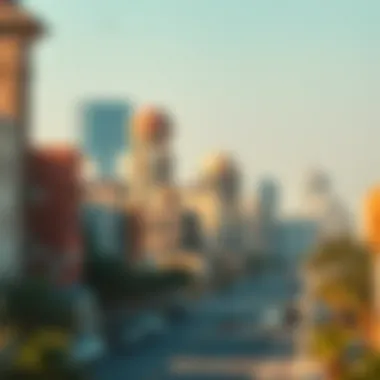

Additionally, the focus on public spaces has increased, with parks and community centers becoming focal points for social interaction. These areas not only enhance the charm of neighborhoods but also promote a sense of community belonging, fostering interactions among diverse residents.
Organizations are also spearheading initiatives aimed at creating a harmonious blend between built and natural environments. The juxtaposition of luxurious residential towers and green spaces stands as a commitment to quality urban living. Through strategic planning, Dubai continues to evolve, ensuring that its neighborhoods remain vibrant and inviting.
Significant Neighborhoods in Dubai
Exploring the significant neighborhoods of Dubai presents an insightful lens into how this city harmonizes modernity with tradition. Each area has its distinct flavor and aesthetic appeal, catering to diverse preferences and lifestyle needs. By understanding these neighborhoods, potential residents and visitors can appreciate the unique interconnections that forge community identity in Dubai. Moreover, significant neighborhoods represent more than physical locations; they encapsulate the cultural ethos and social activities that enhance the quality of life. Thus, a dive into these locales reveals elements influences ranging from architecture to local events, making them vital to comprehending Dubai's metropolitan charm.
Downtown Dubai
Downtown Dubai stands as a monumental district, showcasing Dubai's bold aspirations. This area emanates vibrancy and activity, featuring iconic landmarks like the Burj Khalifa and the Dubai Mall, a shopping haven that offers an abundance of retail and leisure options. The design of Downtown Dubai embodies a blend of modern architecture and luxury, attracting tourists and residents alike. It serves not just as a commercial hub but also as a cultural epicenter, hosting various events throughout the year, from art exhibitions to international music festivals. Furthermore, the neighborhood's urban planning encourages pedestrian-friendly spaces, allowing people to immerse themselves in the community.
Dubai Marina
Dubai Marina is a shimmering testament to modern urban development. The skyline is adorned with sleek skyscrapers, and the area is a mecca for water sports and leisure activities. A significant aspect of living in Dubai Marina is the waterfront lifestyle; the promenade offers a picturesque setting for leisurely strolls, dining, and social interactions. With its array of high-end restaurants and lively cafes, it provides an ideal environment for socializing. The community is also known for various events and gatherings, fostering a tight-knit cultural ambiance, even amidst its bustling commercial activity.
Jumeirah
Jumeirah is synonymous with high-end living and breathtaking coastal views. This neighborhood is characterized by stunning villas, expansive gardens, and proximity to pristine beaches. The area exudes an air of exclusivity while maintaining a welcoming vibe. Residents here enjoy a lifestyle that combines leisure with practicality—luxury shopping is just a stone's throw away, and leisurely afternoons on the beach are part of daily life. The mix of traditional Arabian architecture with contemporary designs creates a visually stimulating landscape, while local eateries and global cuisine options cater to diverse palates. This neighborhood encapsulates a rich cultural narrative, resonating with both locals and expatriates.
Al Quoz
Al Quoz provides a different perspective on the diversity of Dubai’s neighborhoods, reflecting an edgy, artistic vibe that many are beginning to embrace. Once primarily an industrial area, Al Quoz has evolved into a creative hub, featuring art studios, galleries, and cultural initiatives. The mix of modern and traditional elements showcases the dynamic transformation of Dubai, attracting a growing number of artists and entrepreneurs. This resurgence has led to the development of unique markets and food festivals, fostering a vibrant community spirit that celebrates creativity and innovation. Residents find themselves in a place where art meets everyday living, and community interactions flourish in this unconventional urban setting.
Arabian Ranches
For those seeking a family-oriented atmosphere, Arabian Ranches is a prime choice. This suburban neighborhood offers a mix of luxury living and communal amenities, making it ideal for families. The design encourages outdoor activities, with parks, lakes, and cycling pathways that promote a healthy lifestyle. Arabian Ranches is known for its sense of community; frequent social events help foster relationships among residents. Educational institutions and healthcare facilities are conveniently located, contributing to the overall livability of the area. All these aspects underscore the neighborhood’s charm, making it a coveted locale for families looking for tranquility within the urban sprawl.
"In the heart of each community lies the spirit of its people—a unique fabric woven through daily interactions and shared experiences."
Overall, understanding the significant neighborhoods of Dubai unveils layers of lifestyle offerings and cultural richness. Each area possesses its charm, contributing uniquely to Dubai's dynamic mosaic. Whether you're drawn to the opulence of Downtown Dubai or the serene surroundings of Arabian Ranches, each neighborhood tells a story that reflects the city’s evolving identity.
Landscape Features Across Neighborhoods
Dubai's neighborhoods buzz with life, each wrapped in unique landscapes that reflect the city’s dynamic character. These landscapes are not merely about aesthetic appeal; they play a vital role in fostering community well-being and sustainability. Elements such as parks, waterfronts, and architectural diversity contribute to a balanced lifestyle, while also addressing environmental considerations. In a city known for its rapid development, the landscape features serve as green lungs, calming the urban beat and providing residents and visitors alike places to unwind and connect.
Parks and Green Spaces
Parks and green spaces in Dubai are like hidden jewels—vital for the community, yet often underappreciated. Areas such as Al Barsha Pond Park and Safa Park beckon outdoor enthusiasts with their sprawling lawns, walking trails, and serene artificial lakes. These parks act as communal hubs, offering recreational activities for families and individuals.
- Health Benefits: Being around greenery has a calming effect. Research shows that spending time in parks diminishes stress, improves mood, and can enhance physical health.
- Cultural Significance: Parks host various events, from traditional festivals to modern musical gatherings, promoting social interaction across diverse populations.
- Environmental Role: Green areas contribute to temperature regulation, serving as natural air conditioners to mitigate the heat common in urban settings.
However, a challenge remains—the pressure to maintain these green sanctuaries as the city grows. Efficient urban planning is crucial to ensure these pockets of greenery don’t disappear under concrete.
Waterfronts and Beaches
Waterfronts and beaches in Dubai are a breathtaking sight, blending natural beauty with urban sophistication. Locations like JBR beach and the Dubai Marina waterfront are not just for relaxation, but they also encapsulate the essence of community life. Families and friends gather here, enjoying the sun, sand, and vibrant atmosphere.
- Leisure Activities: Whether it’s beach volleyball, jogging along the promenades, or simply lounging with a view of the glittering skyline, waterfronts promote a healthy, active lifestyle.
- Economic Impact: These areas attract tourists and locals, supporting businesses ranging from restaurants to water sports activities that boost the local economy.
- Community Engagement: Events like food festivals and cultural performances take place along these waterfronts, drawing everyone together and fostering local pride.
While waterfronts are vital, developing them sustainably is key to balancing economic benefits with environmental stewardship. Protecting marine life and coastal ecosystems should be a priority alongside urban development.
Architectural Landscaping
Architectural landscaping stitches together the narrative of the city's development, creating spaces that are both functional and visually compelling. In neighborhoods like Downtown Dubai and Jumeirah, the interplay between nature and structure stands out. Think of Burj Khalifa framed against a landscape dotted with manicured gardens and reflection pools.
- Innovative Design: The architectural landscape is not just about buildings; it's also about how they integrate with their surroundings. For example, the interplay of natural elements with high-rise towers showcases a commitment to thoughtful urban design.
- Aesthetic Value: Landscapes play a crucial role in elevating architectural forms. Buildings like the Museum of the Future are surrounded by landscaping that enhances their unique features.
- Functionality: Beyond aesthetics, thoughtful landscaping provides shade and insulation, making urban spaces more comfortable during hot months.
However, navigating the challenges of maintaining a cohesive architectural identity while promoting green spaces can be tricky. Planning needs to embrace both innovative design and ecological principles for truly sustainable growth.
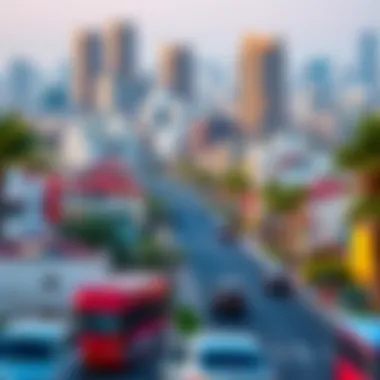

In sum, the landscape features across Dubai's neighborhoods are essential building blocks of community life. They not only enhance the urban environment but enrich the social fabric of the city, offering cherished spaces for recreation, connection, and growth.
Cultural and Community Life
Cultural and community life in Dubai serves as the lifeblood of its vibrant neighborhoods. Each area possesses unique traditions, norms, and social dynamics that contribute to the overall essence of the city. Understanding the intricacies of community interactions, cultural events, and social structures provides a clearer lens through which to view the diverse tapestry of Dubai. This section explores how cultural expression fosters a sense of belonging among residents, while also attracting visitors keen to experience local life and customs.
Festivals and Events
Festivals and events in Dubai are a kaleidoscope of color, culture, and camaraderie. The city hosts numerous celebrations throughout the year, reflecting its rich heritage and multicultural population. Noteworthy among them is the Dubai Shopping Festival, a month-long extravaganza that merges shopping discounts with performances and fireworks.
There’s also Eid Al-Fitr and Eid Al-Adha, celebrated with fervor by the local Muslim community. These events not only bring families together for feasts but quite often, they are marked by public celebrations featuring cultural performances.
From the Dubai Food Festival, which showcases the culinary diversity of the city, to the Dubai International Film Festival, there is no shortage of activities that bring residents and visitors alike into the communal fold. This melting pot of festivities not only enrichens community ties but makes Dubai a year-round destination for cultural tourism, putting the spotlight on its diverse heritage.
Marketplaces and Shopping Districts
Dubai is renowned for its shopping experience, yet its marketplaces offer more than just consumer goods. The Gold Souk and The Spice Souk are prime examples of traditional marketplaces, offering not just products, but a slice of culture. Walking through the narrow lanes, the vibrant colors and enticing scents invite visitors to engage in the age-old art of haggling.
These bustling bazaars are often spaces for social interaction, where locals catch up over a cup of Arabic coffee or indulge in friendly banter. The contemporary shopping districts, such as The Dubai Mall, though modern in architecture, still aim to recreate a sense of community with art installations, parks, and areas for social gatherings within their premises.
Art and Cultural Institutions
The role of art and cultural institutions cannot be undervalued in shaping the cultural landscape of Dubai. Institutions like Alserkal Avenue in Al Quoz nail the concept of community-centric art spaces, offering galleries and studios that champion both local and international artists. They not only host exhibitions but foster interactive workshops and discussions, creating a platform for dialogue.
Conversely, the Dubai Opera stands as a beacon for performing arts in the region. Its architectural elegance parallels its role in promoting a cultural exchange through various performances—from operas to ballets—thus transforming the city into a cultural hub.
Moreover, various cultural festivals such as the Dubai Culture Summit not only engage art lovers but also promote the arts as a pathway for self-expression and social cohesion.
"The blend of modernity and tradition in Dubai's cultural events truly captures the spirit of its communities."
As we unravel the layers of Dubai's cultural and community life, it's clear that these elements foster connections not only among residents but with visitors. The celebrations, marketplaces, and artistic endeavors create a sense of home, making Dubai more than just a city—it's a vibrant communal experience.
The Role of Real Estate in Neighborhood Development
Real estate development stands at the very core of how neighborhoods in Dubai evolve and flourish. The relationship between property developments and the social fabric of communities cannot be overstated. Essentially, every tower, every villa complex, and every retail space contributes to the broader narrative of urban life. The establishment of new neighborhoods not only alters the skyline but also reshapes lifestyles, creates employment opportunities, and introduces amenities that can significantly enhance the quality of life for residents.
When developers set their sights on a particular area, they often take into account the existing infrastructure and the potential for growth. This strategic planning allows them to create not just places to live but vibrant ecosystems where residents can thrive. For example, in neighborhoods like Dubai Marina, residential buildings are meticulously planned to provide stunning views of the water, combined with easy access to leisure facilities. This integration of nature with urban living is instrumental in fostering unique community identities.
Trends in Property Development
In recent years, the trends in property development within Dubai have reflected broader global shifts toward sustainability, technology integration, and mixed-use spaces. These trends cater to the modern demands of both residents and investors.
- Sustainability is a key focus, with developers opting for eco-friendly materials and energy-efficient designs. Projects such as The Sustainable City demonstrate how green initiatives are incorporated into living spaces, aiming to reduce the residents' carbon footprint while enhancing aesthetic appeal.
- Smart technology is another emerging trend. The advent of smart homes allows residents to control different aspects of their living environment—from lighting to temperature—through their smartphones, creating not just comfort but immense convenience.
- Mixed-use developments are also gaining traction. These are spaces where residential, commercial, and recreational facilities coexist harmoniously. It’s not uncommon to find vibrant markets, cafes, and parks intermingled with residential units, fostering community engagement.
Adapting to these trends indicates that real estate developers are not simply selling property but are, in essence, curators of experiences and lifestyles.
Investing in Dubai's Real Estate Market
With the infrastructure continually evolving and new regulations being put in place, Dubai's real estate market offers a lucrative venture for both local and foreign investors. The attractiveness of the market stems from several factors:
- Tax Incentives: Dubai offers a relatively low tax environment, with no property tax, making it attractive for investors looking to grow their portfolios.
- High Rental Yields: Compared to many cities worldwide, Dubai boasts relatively high rental yields. In certain neighborhoods, these can reach up to 8% or more, compelling many to consider property investment as a viable income stream.
- Increasing Demand for Housing: The population in Dubai continues to grow due to its status as an international business hub. More residents create increased demand for housing, further driving market growth.
However, as is the case with any investment, potential buyers need to conduct thorough research and consider various aspects, including location, neighborhood development plans, and market trends. Engaging with local property experts can provide invaluable insights into navigating this evolving landscape.
"Investing in Dubai real estate is not merely about bricks and mortar; it’s about investing in a vision that aligns with the future of urban living."
As Dubai continues to innovate and develop, the role of real estate in shaping the neighborhoods will remain pivotal, offering opportunities and challenges for all stakeholders in the community.
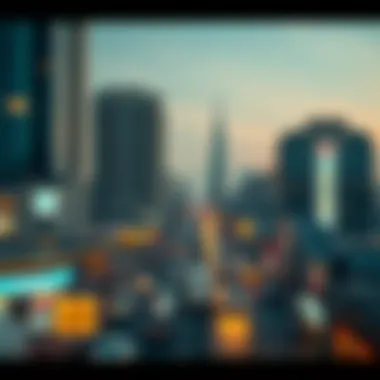

Lifestyle Qualities of Dubai's Residents
When looking into the diverse neighborhoods of Dubai, one cannot overlook the unique lifestyle qualities that shape the experience of its residents. These qualities are not just about the physical surroundings, but also about how people interact with their environment and each other. Understanding these nuances is essential for anyone considering a move to the city or simply wanting to grasp its vibrant culture.
Demographics and Social Structure
Dubai's demographic tapestry is a striking mix of cultures and backgrounds. As of a recent report, nearly 90% of Dubai's population comprises expatriates. This melting pot contributes to a cosmopolitan way of life that celebrates diversity. People from all corners of the globe have found a home here, meaning neighborhoods often represent a mosaic of traditions, cuisines, and languages. The social structure leans towards a fast-paced lifestyle, where people are often balancing work commitments with family life and social engagements. This diversity encourages adaptability and openness among residents, leading to a strong feeling of community despite the city's rapid growth.
As new neighborhoods develop, the demographics can shift quickly, which can affect aspects like educational choices and public utilities. Young families might gravitate towards areas with good schools and parks, while professionals often seek lively districts that offer dining and entertainment options.
Work-Life Balance in Urban Settings
Living in a bustling metropolitan area such as Dubai presents both opportunities and challenges when it comes to work-life balance. The city is known for its economic vitality, drawing in talent from around the world. However, this can create demand that often leads to longer working hours. Many companies expect a certain level of commitment that can blur the lines between personal time and professional obligations.
Yet, despite these demands, residents have found ways to carve out a balanced lifestyle. Neighborhoods like Dubai Marina offer a plethora of recreational activities, from beach access to jogging paths, catering to the active lifestyles of its residents. Additionally, many individuals engage in community gatherings or social clubs, fostering connections beyond the workplace.
It’s also noteworthy that some employers are beginning to adopt more flexible work arrangements. This change has made a significant impact, allowing families to spend quality time together while ensuring productivity at work.
In a nutshell, the lifestyle qualities resident in Dubai contribute significantly to their overall well-being and satisfaction. As neighborhoods evolve, one can only imagine how these dynamics will shape the future community life in this global metropolis.
“Dubai’s neighborhoods are as diverse as its residents, creating a unique symphony of cultures that is both beautiful and complex.”
Sustainability and Future Developments
Sustainability in urban environments is no longer just a buzzword; it’s become a necessity. With rapid urbanization, particularly in cities like Dubai, understanding sustainability practices can redefine how communities grow and flourish. In this context, sustainability refers to building smarter, greener environments that can cope with challenges such as climate change, population growth, and resource scarcity. The emphasis on sustainability shapes future developments by incorporating eco-friendly practices into urban planning, thereby enhancing the quality of life for residents.
To create a balanced community, the role of sustainability cannot be overstated. Sustainable practices harness natural resources while minimizing environmental impact. They not only contribute to a healthier environment but also provide long-term economic benefits, proving that good planning is as much about tomorrow as it is about today.
Green Initiatives in Urban Planning
Dubai is making strides in adopting green initiatives that are set to transform its neighborhoods into sustainable havens. Initiatives like the Dubai Clean Energy Strategy 2050 are designed to ensure that the city runs on clean energy. This goal is evident in projects like the Mohammed bin Rashid Al Maktoum Solar Park, which is among the largest renewable energy projects in the region.
- Parks and Renewable Spaces: One notable effort is the integration of parks and solar energy solutions within existing urban landscapes. Parks like the Emirates Park feature spaces with solar panels, allowing for natural climate control and habitat support.
- Water Conservation: Innovative water management systems are being implemented. These systems focus on the reuse of treated wastewater for landscape irrigation, conserving vital fresh water resources.
- Sustainable Transport: Moreover, Dubai’s ongoing efforts to promote electric vehicles and establish extensive cycling paths encourage an urban lifestyle that is less reliant on fossil fuels. This not only lessens traffic congestion but also boosts air quality.
"Implementing sustainable initiatives is not just about adapting; it's about thriving in harmony with our environment."
The Impact of Technology on Urban Landscapes
The integration of technology into urban planning in Dubai offers exciting opportunities for reimagining city living. With the rise of smart cities, technology facilitates intricate systems that enhance sustainability and user experience. Smart sensors help manage everything from traffic flow to energy consumption in real-time, allowing for dynamic adjustments to ensure efficiency.
- Data-Driven Decisions: By utilizing big data, planners can make informed choices about resource allocation and infrastructure development which cater to actual usage patterns rather than estimated projections.
- Green Architecture: Smart home technologies and green architecture concepts are becoming more commonplace. Buildings equipped with energy-efficient systems or even integrated with AI for optimizing energy use contribute to longer-term sustainability goals.
- Community Engagement: Technology also empowers residents. Digital platforms allow community members to engage in discussions regarding local development projects, fostering a sense of ownership and accountability. This open dialogue supports sustainable community practices by aligning development goals with resident needs.
Epilogue
The concluding section of this article is crucial as it wraps up the diverse landscapes explored throughout Dubai's neighborhoods, emphasizing their individual characteristics and communal significance. The neighborhoods of Dubai reflect the city’s growth and transformation, showcasing not just architectural variety, but also the vibrancy of community life. This diversity enhances the experience of residents and visitors alike, adding layers of cultural richness that underscore the city’s unique identity.
Recapitulating the Landscape Diversity
Dubai’s neighborhoods are a mosaic of landscapes, each telling its own story. From the ultramodern skyscrapers in Downtown Dubai to the serene, sprawling greenery of Arabian Ranches, the city embodies a varied repertoire of urban design. This rich array is not just about aesthetics; it represents the confluence of tradition and modernity.
- Park and Green Spaces: Many neighborhoods prioritize green spaces, making them livable and inviting. Parks within urban settings like Dubai Marina or the lush landscapes of Jumeirah serve as communal hubs.
- Architectural Diversity: Building styles range from contemporary to classic Arabic designs, reflecting a blend of cultures and influences. Notably, the museum-like structures present in areas like Al Quoz capture a narrative that goes beyond traditional design, acting as canvases for artistic expression.
Through a closer look at specific neighborhoods, one appreciates how each contributes to the rich tapestry of Dubai’s urban environment. This diversity in landscape also encourages a variety of lifestyles and social interactions, making each community unique while fostering a sense of belonging among residents.
The Future of Dubai Neighborhoods
Looking ahead, the evolution of Dubai's neighborhoods will likely continue to be shaped by innovative urban planning and sustainability efforts. With increasing focus on eco-friendly designs and smart technology, neighborhoods are expected to transition into more sustainable living spaces.
- Green Initiatives: Projects aimed at enhancing public transportation and increasing green spaces will redefine how residents engage with their surroundings. By integrating parks and bike lanes, for instance, the city aims to promote healthier lifestyles.
- Cultural Investment: As neighborhoods evolve, there is a growing emphasis on cultural institutions and community events. This fosters deeper engagement among diverse populations and promotes social cohesion.
"The neighborhoods of Dubai are not simply places of residence; they are evolving ecosystems that reflect sociocultural dynamics and future aspirations."
With a robust foundation laid for continuous growth, it’s evident that the neighborhoods will not only adapt but also thrive, becoming models of modern urban living that seamlessly blend tradition and innovation. Planning and investment will play pivotal roles in this journey, determining how Dubai's unique neighborhoods will unfold in the coming years.
In summary, understanding these neighborhoods provides valuable insights for homeowners, visitors, and planners, helping them appreciate what makes Dubai a fascinating place to live and explore.










